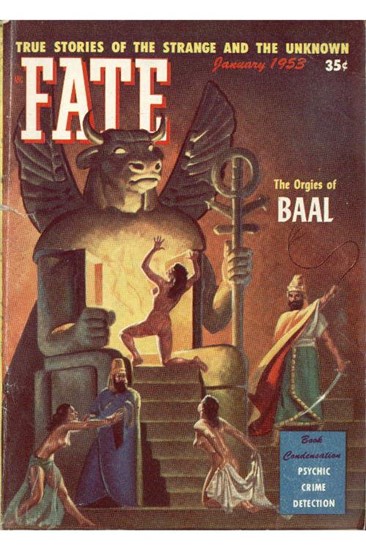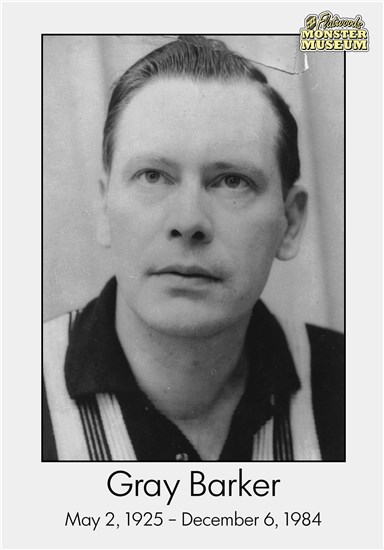The town of Riffle is a small, close-knit, community in central West Virginia. Located in Braxton County near the borders of Gilmer and Calhoun Counties, Riffle couldn’t be much more rural, unassuming, or off the beaten path, but on May, 2nd 1925 a man was born who would come to play a significant role in developing Ufology and the lore and story-telling which would accompany it. That man was Gray Barker.
Gray grew up in Braxton County and would go on to attend Glenville State College. For a short time after college Baker taught English at a Maryland high school. Barker was an avid reader and had a keen interest in real-life accounts of alien and other paranormal encounters as well as science fiction.
Barker was one of the first to write about the Flatwoods Monster sighting. His article, “The Monster and the Saucer,” was published in FATE Magazine in January 1953.

Barker would go on to write the books: They Knew too much about Flying Saucers, this book touches on the Flatwoods Monster incident as well as other UFO/paranormal related stories. Beginning in 1959, Barker produced The Saucerian/The Saucerian Bulletin in Clarksburg, WV

In 1970, Barker published his well-known book, “The Silver Bridge.” In which, Barker regaled readers with the Mothman sightings that took place around Point Pleasant, WV before the collapse of the Silver Bridge in 1966. Throughout the 1970’s and early 1980’s, Barker continued to publish his own works as well as others via the Saucerian Press. In 1983, Barker released “Men in Black: The Secret Terror Among Us.” In the book, Barker provided readers with additional and updated stories about the men in black. Though stories of the Men in Black were reported before Barker wrote about them, it was Barker’s writings which propelled the MIB into the public consciousness. The Flatwoods Monster Museum has two first editions of “They Knew too Much about Flying Saucers” on display

With Barker’s passing, we must surely close the door on the ‘classic’ era of saucer research—an era which really ended in the 1950’s, with mere echoes in more recent years.
James Moseley—SAUCER Smear—December 1984
In the autumn of 1984, Barker began to struggle with a difficult illness. He was admitted and released from a local hospital in October. By late November, Barker had been admitted to an Intensive Care Unit in Charleston, WV. He died there on December 6, 1984. James Moseley commemorated Barker’s passing with a column devoted to him. Barker’s death was noted by publications throughout the UFO community.
Over the course of his life, Barker frustrated many ufologists with his well-crafted stories and cleverly devised hoaxes. Barker wrote what is (and at that time was) considered science-fiction; even though, Barker preferred to classify his works as ‘true stories.’ Barker advised John Sherwood to remove a line stating the story was fictional, and to publish documents from the agency in the story to make the piece more realistic before he would publish it. Barker understood that by making the unbelievable believable, he could sell his publications.
While Barker’s reputation as a scholarly writer was questionable, his creative writing style inspired a generation of readers to dream about UFOs. His works sparked debates among ufologists and enthusiasts around the world, pushed the boundaries of science fiction, and introduced UFO lore to popular culture. Barker was one of many writers who flourished during the heyday of UFOs. The value of his works as science fiction will linger for future generations.
Sources
- Barker, Gray. “Believes in Flying Saucers.” (Nicholas County) News Leader, 15 September 1953.
- Barker, Gray. Letter to August Roberts. 5 August 1953. Gray Barker Collection. Roberts—Correspondence With Gray Barker. Clarksburg-Harrison Public Library, Clarksburg, WV.
- Barker, Gray. Letter to Frank Scully. 14 September 1959. Gray Barker Collection. Scully, Frank. Clarksburg-Harrison Public Library, Clarksburg, WV.
- Barker, Gray. Men In Black: The Secret Terror Among Us. Jane Lew, WV: New Age Press, 1983.
- Barker, Gray. The Silver Bridge. Clarksburg, WV: Saucerian Books, 1970.
- Barker, Gray. They Knew Too Much About Flying Saucers. New York, NY: University Press, 1956.
- Barker, Gray, editor. SAUCER News 15, no. 1-17, no. 1 (1968-1970).
- Barker, Gray. “The Monster and The Saucer.” FATE 6, no. 1 (January 1953):12-20.
- Clark, Jerome. Books News & Reviews. FATE 36, no. 12 (December 1983): 95-104.
- Clark, Jerome. “Gray Barker Dies. . .” FATE 38, no. 4 (April 1985).
- Clark, Jerome. The UFO Encyclopedia: The Phenomenon from the Beginning, Second Edition. Volume 1. Detroit, MI: Omnigraphics, Inc., 1998.
- Contract of Sale. 23 February 1963. Gray Barker/James Moseley. Gray Barker Collection. Miscellaneous Barker/Moseley Correspondence. Clarksburg-Harrison Public Library, Clarksburg, WV.
- Lewis, James R. UFOs and Popular Culture: An Encyclopedia of Contemporary Myth. Santa Barbara, CA: ABC-CLIO, Inc., 2000.
- Moseley, James. Miscellaneous Ravings. SAUCER Smear 31, no. 9 (December 15, 1984): 1-2.
- Moseley, James and Karl T. Pflock. Shockingly Close to the Truth: Confessions of a Grave-robbing Ufologist. Amherst, New York: Prometheus Books, 2002.
- SAUCER News Press Release. SAUCER News. (Winter 1967/1968). Gray Barker Collection. SAUCER News Miscellaneous Bound Volume. Clarksburg-Harrison Public Library, Clarksburg, WV.
- Sherwood, John C. “Gray Barker: My Friend, the Myth-Maker.” Skeptical Inquirer 22.3, May/June 1998. http://www.csicop.org/si/sho/gray_barker_my_friend_the_myth-maker (accessed 7 July 2010).
- Sherwood, John C. “Gray Barker’s Book of Bunk: Mothman, Saucers, and MIB.” Skeptical Inquirer 26.3, May/June 2002. http://www.csicop.org/si/show/gray_barkers_book_of_bunk_mothman_ saucers_and_mib/ (accessed 7 July 2010).
- Story, Ronald D., editor. The Encyclopedia of UFO’s. Garden City, NY: Dolphin Books, 1980.
- Straith, R. E., Letter to George Adamski . 6 December 1956. Gray Barker Collection. R. E. STRAITH #1. Clarksburg-Harrison Public Library, Clarksburg, WV.
- Whispers From Space. Directed by Ralph Coon. Burbank, CA: the Last Prom, 1995. DVD.